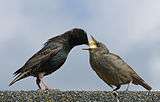Kleptoparasitism
Kleptoparasitism[lower-alpha 1] (etymologically, parasitism by theft) is a form of feeding in which one animal takes prey or other food that was caught, collected, or otherwise prepared by another animal, including stored food. Examples of this last case include cuckoo bees, which lay their eggs on the pollen masses made by other bees, or the hosts of parasitic or parasitoid wasps. The term is also used to describe the stealing of nest material or other inanimate objects from one animal by another.
The kleptoparasite gains prey or objects not otherwise obtainable or which otherwise require time and effort. However, the kleptoparasite might be injured by the victim in cases in which the latter defends its prey. Kleptopredation is the practice of choosing prey that has recently fed.[1][2]
Kleptoparasitism may be intraspecific (the parasite is the same species as the victim) or interspecific (the parasite is a different species). In the latter case, the parasites are commonly close relatives of the organisms they parasitize ("Emery's Rule").
Animals that have extraordinarily specialized feeding methods are often targets of kleptoparasitism. For example, oystercatchers are unusual in being able to break through the shells of mussels; adult oystercatchers suffer intraspecific kleptoparasitism from juveniles that are not yet strong or skillful enough to open mussels easily. A fox or a coyote could lose its kill to a brown bear, gray wolf, or even a bald eagle. Diving birds that bring their prey to the surface suffer interspecific kleptoparasitism from gulls, which are unable to fetch fish from the sea floor themselves.
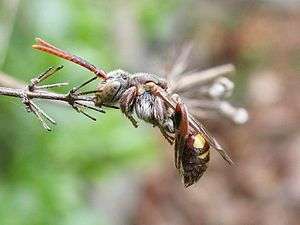
Bees and wasps
There are many lineages of cuckoo bees, all of which lay their eggs in the nest cells of other bees, often within the same family.[3] Bombus bohemicus, for example, parasitises several other species of Bombus, including Bombus terrestris, Bombus lucorum (white-tailed bumblebee), and Bombus cryptarum.[4] The largest monophyletic lineage of kleptoparasitic bees is Nomadinae (a subfamily of Apidae), which comprises several hundred species in 35 genera, all of which are kleptoparasites.[5]
| Host genus | Parasite genus and subgenus |
|---|---|
| Bombus | Bombus (Psithyrus) |
| Anthophora | Melecta, Zacosmia |
| Amegilla | Thyreus |
| Megachile | Coelioxys |
The cuckoo wasps include the family Chrysididae.[6] Many species of chrysidid lay their eggs in the nests of potter and mud dauber wasps. Other families of wasps have "cuckoo" species that parasitise related species, as for example the vespid Polistes sulcifer, which parasitises a related species, Polistes dominula.[7][8] Numerous other wasp families have genera or larger lineages of which some or all members are kleptoparasitic (e.g., the genus Ceropales in Pompilidae and the tribe Nyssonini in Crabronidae). While these insects are usually referred to as kleptoparasites[3] other terms used (not exact synonyms) are inquiline and brood parasite.[9] Another term used is kleptoparasitoid which has been defined as a "parasitoid that increases its reproductive success at the cost of another parasitoid, by preferring hosts that have been parasitized (or sometimes only found) by another female". Kleptoparasitoids may make use of the punctures made by previous parasitoids on their hosts; make use of the trails or traces left by parasitoids to locate hosts; or use hosts that have already been weakened by other parasitoids.[10]
Flies
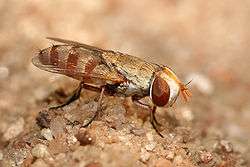
Some flies are kleptoparasites, which is especially common in the subfamily Miltogramminae of the family Sarcophagidae. There are also some kleptoparasites in the families Chloropidae and Milichiidae. Some adult milichiids, for example, visit spider webs where they scavenge on half-eaten stink bugs. Others are associated with robber flies (Asilidae), or Crematogaster ants.[11] Flies in the genus Bengalia (Calliphoridae) steal food and pupae transported by ants and are often found beside their foraging trails.[12] Musca albina (Muscidae) reportedly shows kleptoparasitic behaviour, laying eggs only in dung balls being interred by one out of several co-occurring dung-rolling scarab species.[13]
Dung beetles
Scarab dung beetles relocate vast amounts of vertebrate dung to establish their nests. A few species do not transport dung materials, but merely use reserves made by other species, either "roller" or "tunneller". Examples are the genus Cleptocaccobius (small species parasiting balls of roller dung beetles), and the genus Pedaria (whose species nidificate in the nests of large tunneller dung beetles in tropical Africa).
True bugs

Many semiaquatic bugs (Heteroptera) are known to engage in kleptoparastism of prey. In one study, whenever the bug Velia caprai (water cricket) took prey heavier than 7.9 g, other bugs of the same species joined it and successfully ate parts of the prey.[14]
Ants
Spiders

Kleptoparasitic spiders, which steal or feed on prey captured by other spiders, are known to occur in five families:
- Theridiidae (Argyrodes species)
- Dictynidae (Archaeodictyna ulova)
- Salticidae (species of Portia and Simaetha)
- Symphytognathidae (Curimagua bayano)
- Mysmenidae (Isela okuncana, Kilifia inquilina, and Mysmenopsis species).[15]
Vertebrates
Birds
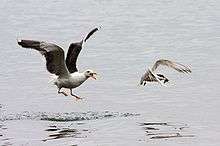
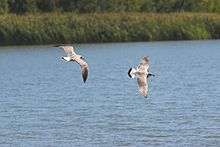
Kleptoparasitism is relatively uncommon in birds.[16] However, some non-passerine groups, such as skuas, jaegers and frigatebirds, rely extensively on such behavior to obtain food, and others—including raptors, gulls, terns, coots, and some ducks and shorebirds—will do so opportunistically. Among opportunistic species such as the roseate tern, research has found that parent birds involved in kleptoparasitism are more successful in raising broods than non-kleptoparasitic individuals.[17] Bald eagles have also been seen attacking smaller raptors, such as ospreys, to steal fish away from them.[18] Among passerine birds, there are fewer known examples of kleptoparasitism, though masked shrikes have been recorded stealing food from wheatears,[19] and Eurasian blackbirds have been seen stealing smashed snails from other thrushes.[16]

Skuas (including the smaller species known as jaegers in North America) are masters of piracy. Their victims are typically gulls and terns, though other fish-eating species (including auks) are also pursued until they disgorge their catches. The fact that skuas are swift and agile fliers—and that they sometimes gang up on a single victim—aids in their success rate.
During seabird nesting seasons, frigatebirds will soar above seabird colonies, waiting for parent birds to return to their nests with food for their young. As the returning birds approach the colony, the frigatebirds (which are fast and agile) swoop in to pursue them vigorously; they have been known to seize tropicbirds by their long tail plumes. Many of the frigatebirds' colloquial names, including man-o'-war bird and pirate of the sea, are a clear reference to this kleptoparasitic behaviour.[20] A study of kleptoparasitism in the magnificent frigatebird suggests that the amount of food obtained by kleptoparasitism may be marginal.[21]
Gulls are known to be perpetrators as well as the victims of kleptoparasitism, with some species frequently exhibiting this behavior, particularly during breeding season. While the victim is most often another member of the same species, other (principally smaller) gulls and terns can also be targeted. In the Americas, Heermann's gulls, and laughing gulls are known to steal food from brown pelicans; as the pelicans surface and empty the water from their bills, the gulls lurk nearby and grab escaping food items.[22] Great black-backed gulls are skilled kleptoparasites, which have been observed to steal not only from other gulls but also from raptors. Several species of gull also steal food from humans, for example takeaway food at seaside resorts.[23]
Several species of coots and gallinules have been recorded engaging in kleptoparasitism.[24] American coots often feed in the company of other waterfowl species, and occasionally will rob diving ducks—including ring-necked ducks, redheads and canvasback—when they surface with food. Eurasian coots steal from conspecifics, as well as from diving and dabbling ducks, and swans. Allen's gallinules rob both conspecifics and African pygmy geese.
Mammals
The relationship between spotted hyenas and lions, in which each species steals the other's kills,[25] is a form of kleptoparasitism.[14] Cheetahs are often targets of kleptoparasitism. Bears, coyotes and wolves are very opportunistic and all have this behavior. All hyena species engage in this behavior when they can, and jackals also steal from other carnivores' kills.[26] Sperm whales sometimes steal fish from fishermen's lines, making them the largest of all kleptoparasites.[27]
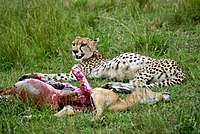
 Three minutes later: this spotted hyena and another are running towards the kill
Three minutes later: this spotted hyena and another are running towards the kill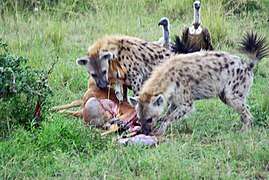 Thirty-eight seconds later: The cheetah has fled without resistance. The vultures will also engage in kleptoparasitism: when the hyenas move a piece of the carcass, the vultures will take scraps from the ground.
Thirty-eight seconds later: The cheetah has fled without resistance. The vultures will also engage in kleptoparasitism: when the hyenas move a piece of the carcass, the vultures will take scraps from the ground.
Humans
Human intraspecific kleptoparasitism (humans taking food from other humans) is common in times of famine.
In falconry, humans use trained birds of prey for hunting. Humans use tethered cormorants for fishing.
One researcher saw humans chasing lions from captured prey in Waza National Park, Cameroon in 2006. Interviews with Bororo herdsmen suggest this behaviour, which possibly contributes to declining lion populations in the park, is more widespread than recognised.[28][29]
Reptiles
Crocodiles and alligators
Various crocodiles will steal food from other animals: the Nile crocodile is known to steal from big cats and hyenas.
See also
Notes
- Also spelled "cleptoparasitism".
References
- Willis, Trevor J.; et al. (1 November 2017). "Kleptopredation: a mechanism to facilitate planktivory in a benthic mollusc". Biology Letters. 13 (11): 20170447. doi:10.1098/rsbl.2017.0447. PMC 5719379. PMID 29093176.
- Livni, Ephrat (2 November 2017). "Kleptopredation is a new scientific term for super-sizing a meal at sea". Quartz. Retrieved 2 November 2017.
- Peter J.B. Slater; Jay S. Rosenblatt; Charles T. Snowdon; Timothy J. Roper; H. Jane Brockmann; Marc Naguib (30 January 2005). Advances in the Study of Behavior. Academic Press. p. 365. ISBN 978-0-08-049015-1.
- Kreuter, Kirsten; Elfi Bunk (November 23, 2011). "How the social parasitic bumblebee Bombus bohemicus sneaks into power of reproduction". Behavioral Ecology and Sociobiology 66 (3): 475–486. doi:10.1007/s00265-011-1294-z. Retrieved 21 September 2015.
- Roig-Alsina, A. (1991). Cladistic analysis of the Nomadinae s. str. with description of a new genus (Hymenoptera: Anthophoridae). Journal of the Kansas Entomological Society 64(1) 23-37.
- "Family Chrysididae – Cuckoo Wasps". BugGuide. Retrieved 18 February 2015.
- Dapporto L, Cervo R, Sledge MF, Turillazzi S (2004) "Rank integration in dominance hierarchies of host colonies by the paper wasp social parasite Polistes sulcifer (Hymenoptera, Vespidae)". J Insect Physiol 50: 217–223
- Ortolani, I.; Cervo, R. (2009). "Coevolution of daily activity timing in a host-parasite system". Biological Journal of the Linnean Society. 96 (2): 399–405. doi:10.1111/j.1095-8312.2008.01139.x.
- Erler, S.; Lattorff, H. M. G. (2010). "The degree of parasitism of the bumblebee (Bombus terrestris) by cuckoo bumblebees (Bombus (Psithyrus) vestalis)". Insectes Sociaux. 57 (4): 371–377. doi:10.1007/s00040-010-0093-2.
- Kraaijeveld, A. R. (1999). "Kleptoparasitism as an explanation for paradoxical oviposition decisions of the parasitoid Asobara tabida". Journal of Evolutionary Biology. 12: 129–133. doi:10.1046/j.1420-9101.1999.00016.x.
- Wild, A.L. & Brake, I. 2009. Field observations on Milichia patrizii ant-mugging flies (Diptera: Milichiidae: Milichiinae) in KwaZulu-Natal, South Africa. African Invertebrates 50 (1): 205-212.
- Sivinski, J., S. Marshall and E. Petersson (1999) Kleptoparasitism and phoresy in the diptera. Florida Entomologist 82 (2)
- Marshall, S.A. & Pont, A.C. (2013). The kleptoparasitic habits of Musca albina Wiedemann, 1830 (Diptera: Muscidae). African Invertebrates 54(2): 427–430.
- Erlandsson, Ann (1988). "Food sharing vs monopolising prey: a form of kleptoparasitism in Velia caprai (Heteroptera)". Oikos. 53 (2): 203–206. doi:10.2307/3566063. JSTOR 3566063.
- Coyl, F.A.; O'Shields, T.C.; Perlmutter, D.G. (1991). "Observations on the behaviour of the kleptoparasitic spider, Mysmenopsis furtiva (Araneae, Mysmenidae)" (PDF). Journal of Arachnology. 19: 62–66.
- Ehrlich, Paul R.; Dobkin, David S.; Wheye, Darryl; Pimm, Stuart L. (1994). The Birdwatcher's Handbook. Oxford: Oxford University Press. ISBN 0-19-858407-5.
- Shealer, David A.; Spendelow, Jeffrey A.; Hatfield, Jeff S.; Nisbet, Ian C. T. (2005). "The adaptive significance of stealing in a marine bird and its relationship to parental quality". Behavioral Ecology. 16 (2): 371–376. doi:10.1093/beheco/ari008. hdl:10.1093/beheco/ari008.
- Jorde, D.G.; Lingle, G (1998). "Kleptoparasitism by Bald Eagles wintering in South-Central Nebraska" (PDF). Journal of Field Ornithology. 59 (2): 183–188. Archived from the original (PDF) on 2007-08-10. Retrieved 2007-08-21.
- Harris, Tony; Franklin, Kim (2000). Shrikes & Bush-Shrikes. London: Christopher Helm. ISBN 0-7136-3861-3.
- Sibley, David (2001). The Sibley Guide to Bird Life and Behaviour. London: Christopher Helm. ISBN 0-7136-6250-6.
- Calixto-Albarrán, Itzia; Osorno, José-Luis (2000). "The diet of the Magnificent Frigatebird during chick rearing". The Condor. 102 (3): 569–576. doi:10.1650/0010-5422(2000)102[0569:tdotmf]2.0.co;2.
- del Hoyo, Josep; Elliott, Andrew; Sargatal, Jordi, eds. (1996). Handbook of Birds of the World vol. 3. Barcelona: Lynx Edicions. ISBN 84-87334-20-2.
- "Archived copy". Archived from the original on 2012-06-15. Retrieved 2012-08-24.CS1 maint: archived copy as title (link)
- Taylor, Barry; van Perlo, Ber (1998). Rails. London: Christopher Helm. ISBN 1-873403-59-3.
- Estes, Richard D. (1999). The Safari Companion: A Guide to Watching African Mammals. Chelsea Green. pp. 294. ISBN 1-890132-44-6.
- Estes, op. cit., 281–295, 339–346
- "Whale Buffet". Archived from the original on 2007-02-07. Retrieved 2007-03-19.
- Walker, Matt (24 July 2009). "People steal meat from wild lions". BBC Earth News. Retrieved 2009-08-01.
- Schoe, Marjolein; de Iongh, Hans H.; Croes, Barbara M. (6 Jul 2009). "Humans displacing lions and stealing their food in Bénoué National Park, North Cameroon". African Journal of Ecology. Blackwell. 47 (3): 445. doi:10.1111/j.1365-2028.2008.00975.x. Archived from the original on 5 January 2013.
External links
| Wikimedia Commons has media related to Kleptoparasitism. |

